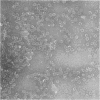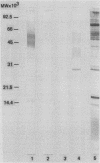Abstract
An immunoglobulin G3 monoclonal antibody obtained by immunizing mice with a cell membrane preparation of epimastigotes of Trypanosoma cruzi was shown to agglutinate live epimastigotes, lyse blood-form trypanosomes, and partially protect mice by passive transfer. The main antigens recognized by the monoclonal antibody were located in the flagella of epimastigotes and blood-form trypanosomes. Antigens of epimastigotes, purified by affinity chromatography with the monoclonal antibody, were shown to be highly glycosylated and revealed a wide band with an Mr between 45,000 and 68,000 in sodium dodecyl sulfate-polyacrylamide gel electrophoresis and immunoblotting. Immunization of mice with a small concentration of the affinity purified antigens incorporated into an antigen delivery system prepared with Quil A (Isotec AB, Lulea, Sweden), a saponin derivative, induced strong antibody and cell-mediated immune responses and protected 100% of the immunized animals against death due to challenge with 100 100% lethal doses of blood form trypanosomes. Protection was due to the use of the antigen delivery system, since mice immunized with equal concentrations of antigens alone or in combination with saponin had 100% mortality. The results suggest that small concentrations of epimastigote antigens obtained by biochemical methods and incorporated into the proper antigen delivery system may serve as a vaccine against Chagas' disease.
Full text
PDF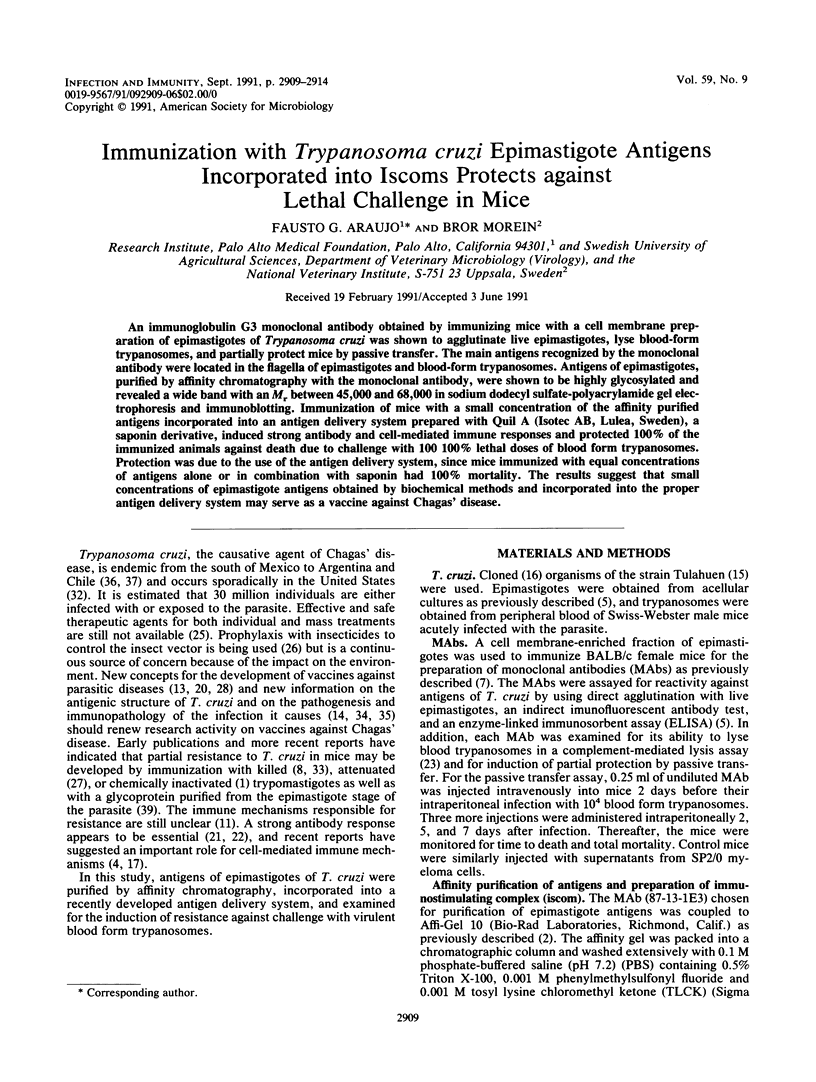
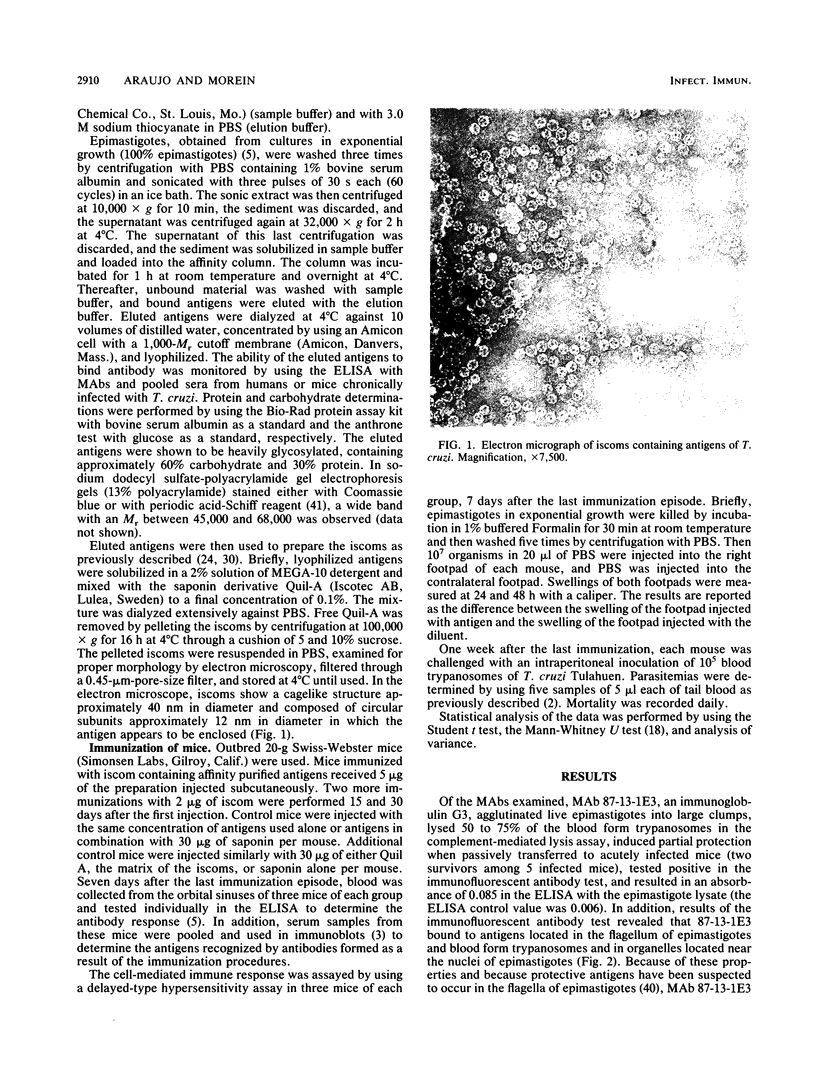
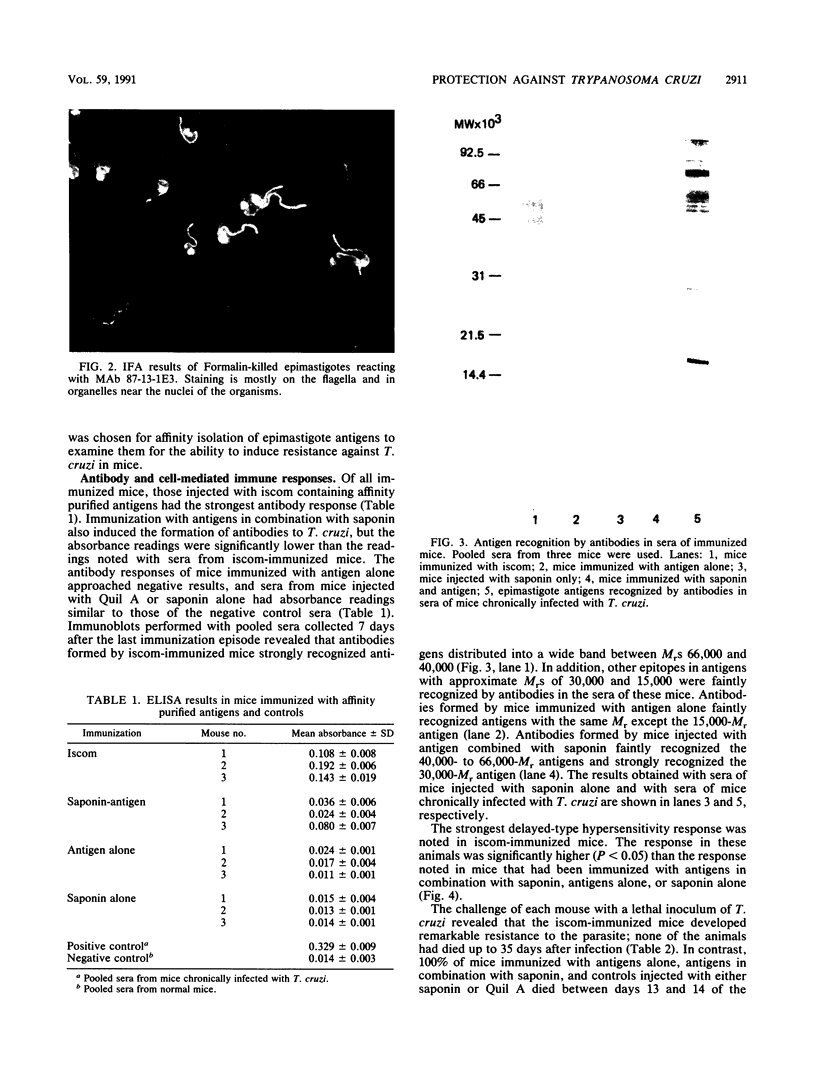
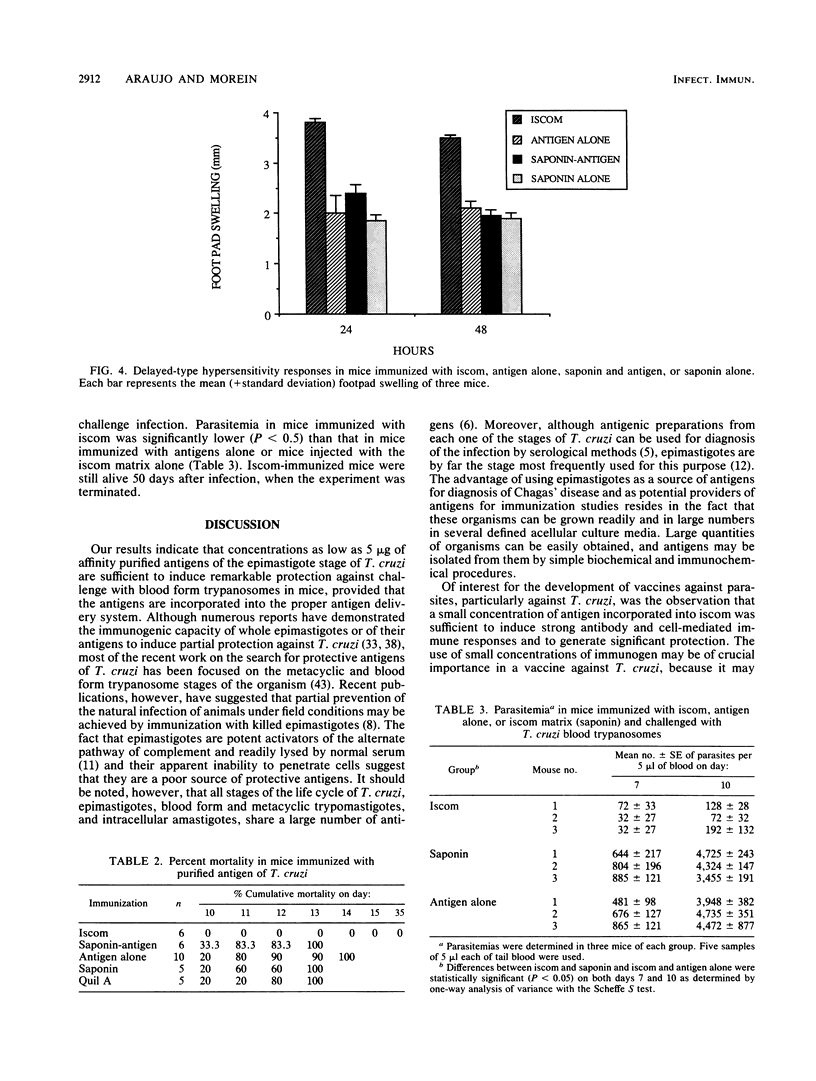
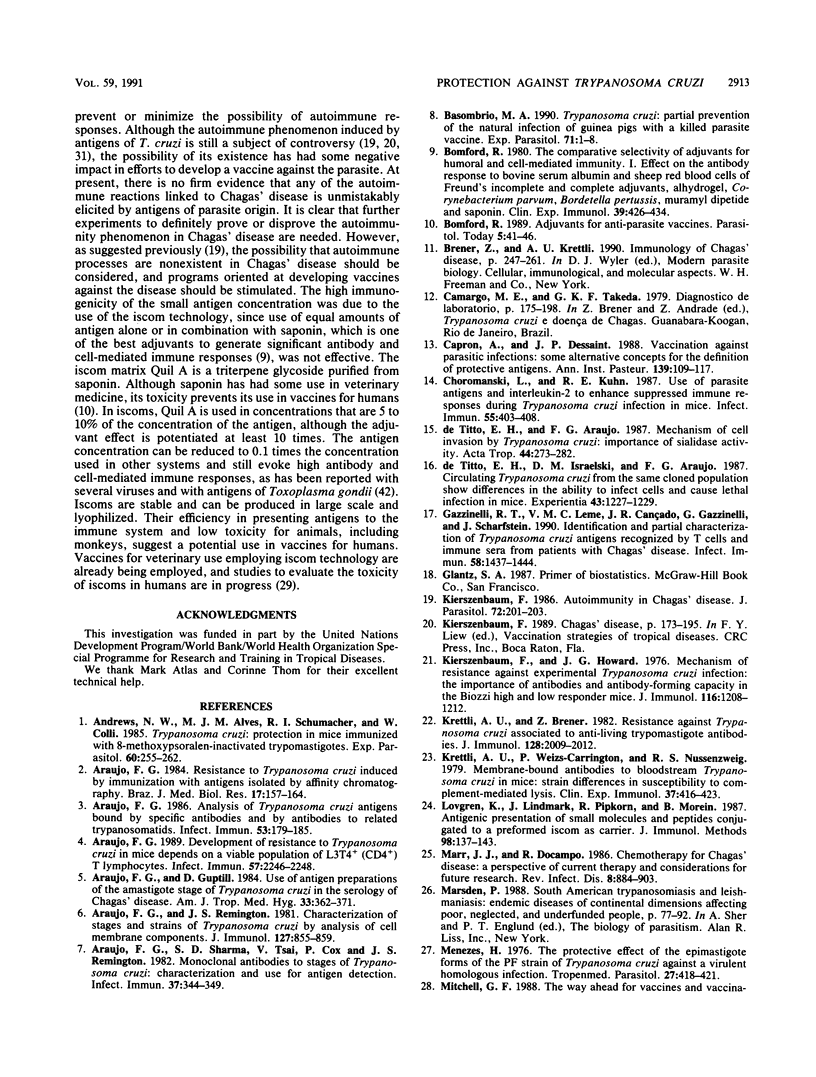
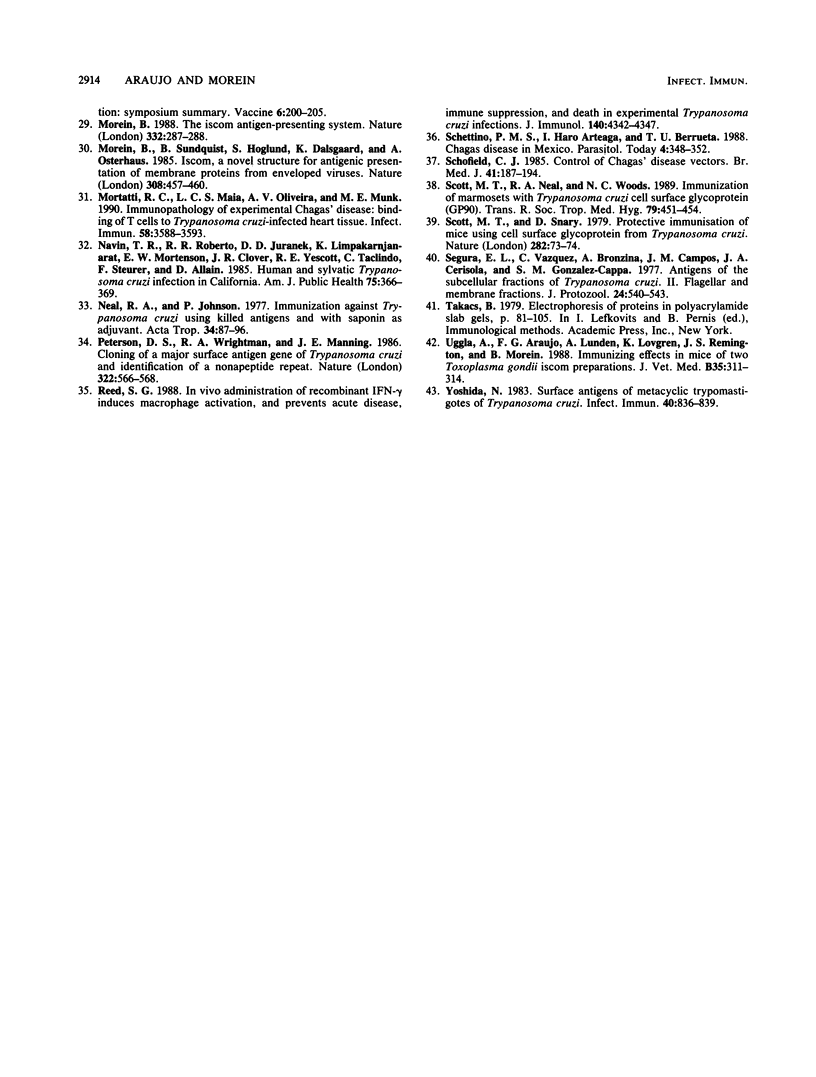
Images in this article
Selected References
These references are in PubMed. This may not be the complete list of references from this article.
- Andrews N. W., Alves M. J., Schumacher R. I., Colli W. Trypanosoma cruzi: protection in mice immunized with 8-methoxypsoralen-inactivated trypomastigotes. Exp Parasitol. 1985 Dec;60(3):255–262. doi: 10.1016/0014-4894(85)90029-3. [DOI] [PubMed] [Google Scholar]
- Araujo F. G. Analysis of Trypanosoma cruzi antigens bound by specific antibodies and by antibodies to related trypanosomatids. Infect Immun. 1986 Jul;53(1):179–185. doi: 10.1128/iai.53.1.179-185.1986. [DOI] [PMC free article] [PubMed] [Google Scholar]
- Araujo F. G. Development of resistance to Trypanosoma cruzi in mice depends on a viable population of L3T4+ (CD4+) T lymphocytes. Infect Immun. 1989 Jul;57(7):2246–2248. doi: 10.1128/iai.57.7.2246-2248.1989. [DOI] [PMC free article] [PubMed] [Google Scholar]
- Araujo F. G., Guptill D. Use of antigen preparations of the amastigote stage of Trypanosoma cruzi in the serology of Chagas' disease. Am J Trop Med Hyg. 1984 May;33(3):362–371. doi: 10.4269/ajtmh.1984.33.362. [DOI] [PubMed] [Google Scholar]
- Araujo F. G., Remington J. S. Characterization of stages and strains of Trypanosoma cruzi by analysis of cell membrane components. J Immunol. 1981 Sep;127(3):855–859. [PubMed] [Google Scholar]
- Araujo F. G. Resistance to Trypanosoma cruzi induced by immunization with antigens isolated by affinity chromatography. Braz J Med Biol Res. 1984;17(2):157–164. [PubMed] [Google Scholar]
- Araujo F. G., Sharma S. D., Tsai V., Cox P., Remington J. S. Monoclonal antibodies to stages of Trypanosoma cruzi: characterization and use for antigen detection. Infect Immun. 1982 Jul;37(1):344–349. doi: 10.1128/iai.37.1.344-349.1982. [DOI] [PMC free article] [PubMed] [Google Scholar]
- Basombrio M. A. Trypanosoma cruzi: partial prevention of the natural infection of guinea pigs with a killed parasite vaccine. Exp Parasitol. 1990 Jul;71(1):1–8. doi: 10.1016/0014-4894(90)90002-t. [DOI] [PubMed] [Google Scholar]
- Bomford R. The comparative selectivity of adjuvants for humoral and cell-mediated immunity. I. Effect on the antibody response to bovine serum albumin and sheep red blood cells of Freund's incomplete and complete adjuvants, alhydrogel, Corynebacterium parvum, Bordetella pertussis, muramyl dipeptide and saponin. Clin Exp Immunol. 1980 Feb;39(2):426–434. [PMC free article] [PubMed] [Google Scholar]
- Capron A., Dessaint J. P. Vaccination against parasitic diseases: some alternative concepts for the definition of protective antigens. Ann Inst Pasteur Immunol. 1988 Jan-Feb;139(1):109–117. doi: 10.1016/0769-2625(88)90135-3. [DOI] [PubMed] [Google Scholar]
- Choromanski L., Kuhn R. E. Use of parasite antigens and interleukin-2 to enhance suppressed immune responses during Trypanosoma cruzi infection in mice. Infect Immun. 1987 Feb;55(2):403–408. doi: 10.1128/iai.55.2.403-408.1987. [DOI] [PMC free article] [PubMed] [Google Scholar]
- Gazzinelli R. T., Leme V. M., Cancado J. R., Gazzinelli G., Scharfstein J. Identification and partial characterization of Trypanosoma cruzi antigens recognized by T cells and immune sera from patients with Chagas' disease. Infect Immun. 1990 May;58(5):1437–1444. doi: 10.1128/iai.58.5.1437-1444.1990. [DOI] [PMC free article] [PubMed] [Google Scholar]
- Kierszenbaum F. Autoimmunity in Chagas' disease. J Parasitol. 1986 Apr;72(2):201–211. [PubMed] [Google Scholar]
- Kierszenbaum F., Howard J. G. Mechanisms of resistance against experimental Trypanosoma cruzi infection: the importance of antibodies and antibody-forming capacity in the Biozzi high and low responder mice. J Immunol. 1976 May;116(5):1208–1211. [PubMed] [Google Scholar]
- Krettli A. U., Brener Z. Resistance against Trypanosoma cruzi associated to anti-living trypomastigote antibodies. J Immunol. 1982 May;128(5):2009–2012. [PubMed] [Google Scholar]
- Krettli A. U., Weisz-Carrington P., Nussenzweig R. S. Membrane-bound antibodies to bloodstream Trypanosoma cruzi in mice: strain differences in susceptibility to complement-mediated lysis. Clin Exp Immunol. 1979 Sep;37(3):416–423. [PMC free article] [PubMed] [Google Scholar]
- Lövgren K., Lindmark J., Pipkorn R., Morein B. Antigenic presentation of small molecules and peptides conjugated to a preformed iscom as carrier. J Immunol Methods. 1987 Apr 2;98(1):137–143. doi: 10.1016/0022-1759(87)90447-9. [DOI] [PubMed] [Google Scholar]
- Marr J. J., Docampo R. Chemotherapy for Chagas' disease: a perspective of current therapy and considerations for future research. Rev Infect Dis. 1986 Nov-Dec;8(6):884–903. doi: 10.1093/clinids/8.6.884. [DOI] [PubMed] [Google Scholar]
- Menezes H. The protective effect of the epimastigote forms of the PF strain of Trypanosoma cruzi against a virulent homologous infection. Tropenmed Parasitol. 1976 Dec;27(4):418–421. [PubMed] [Google Scholar]
- Morein B., Sundquist B., Höglund S., Dalsgaard K., Osterhaus A. Iscom, a novel structure for antigenic presentation of membrane proteins from enveloped viruses. 1984 Mar 29-Apr 4Nature. 308(5958):457–460. doi: 10.1038/308457a0. [DOI] [PubMed] [Google Scholar]
- Morein B. The iscom antigen-presenting system. Nature. 1988 Mar 17;332(6161):287–288. doi: 10.1038/332287a0. [DOI] [PubMed] [Google Scholar]
- Mortatti R. C., Maia L. C., de Oliveira A. V., Munk M. E. Immunopathology of experimental Chagas' disease: binding of T cells to Trypanosoma cruzi-infected heart tissue. Infect Immun. 1990 Nov;58(11):3588–3593. doi: 10.1128/iai.58.11.3588-3593.1990. [DOI] [PMC free article] [PubMed] [Google Scholar]
- Navin T. R., Roberto R. R., Juranek D. D., Limpakarnjanarat K., Mortenson E. W., Clover J. R., Yescott R. E., Taclindo C., Steurer F., Allain D. Human and sylvatic Trypanosoma cruzi infection in California. Am J Public Health. 1985 Apr;75(4):366–369. doi: 10.2105/ajph.75.4.366. [DOI] [PMC free article] [PubMed] [Google Scholar]
- Neal R. A., Johnson P. Immunization against Trypanosoma cruzi using killed antigens and with saponin as adjuvant. Acta Trop. 1977 Mar;34(1):87–96. [PubMed] [Google Scholar]
- Peterson D. S., Wrightsman R. A., Manning J. E. Cloning of a major surface-antigen gene of Trypanosoma cruzi and identification of a nonapeptide repeat. Nature. 1986 Aug 7;322(6079):566–568. doi: 10.1038/322566a0. [DOI] [PubMed] [Google Scholar]
- Reed S. G. In vivo administration of recombinant IFN-gamma induces macrophage activation, and prevents acute disease, immune suppression, and death in experimental Trypanosoma cruzi infections. J Immunol. 1988 Jun 15;140(12):4342–4347. [PubMed] [Google Scholar]
- Salazar Schettino P. M., de Haro Arteaga I., Uribarren Berrueta T. Chagas disease in Mexico. Parasitol Today. 1988 Dec;4(12):348–352. doi: 10.1016/0169-4758(88)90004-x. [DOI] [PubMed] [Google Scholar]
- Schofield C. J. Control of Chagas' disease vectors. Br Med Bull. 1985 Apr;41(2):187–194. doi: 10.1093/oxfordjournals.bmb.a072048. [DOI] [PubMed] [Google Scholar]
- Scott M. T., Neal R. A., Woods N. C. Immunization of marmosets with Trypanosoma cruzi cell surface glycoprotein (GP90). Trans R Soc Trop Med Hyg. 1985;79(4):451–454. doi: 10.1016/0035-9203(85)90061-6. [DOI] [PubMed] [Google Scholar]
- Scott M. T., Snary D. Protective immunisation of mice using cell surface glycoprotein from Trypanosoma cruzi. Nature. 1979 Nov 1;282(5734):73–74. doi: 10.1038/282073a0. [DOI] [PubMed] [Google Scholar]
- Segura E. L., Vazquez C., Bronzina A., Campos J. M., Cerisola J. A., Cappa S. M. Antigens of the subcellular fractions of Trypanosoma cruzi. II. Flagellar and membrane fraction. J Protozool. 1977 Nov;24(4):540–543. doi: 10.1111/j.1550-7408.1977.tb01009.x. [DOI] [PubMed] [Google Scholar]
- Uggla A., Araujo F. G., Lunden A., Lövgren K., Remington J. S., Morein B. Immunizing effects in mice of two Toxoplasma gondii iscom preparations. Zentralbl Veterinarmed B. 1988 May;35(4):311–314. doi: 10.1111/j.1439-0450.1988.tb00501.x. [DOI] [PubMed] [Google Scholar]
- Yoshida N. Surface antigens of metacyclic trypomastigotes of Trypanosoma cruzi. Infect Immun. 1983 May;40(2):836–839. doi: 10.1128/iai.40.2.836-839.1983. [DOI] [PMC free article] [PubMed] [Google Scholar]
- de Titto E. H., Araujo F. G. Mechanism of cell invasion by Trypanosoma cruzi: importance of sialidase activity. Acta Trop. 1987 Sep;44(3):273–282. [PubMed] [Google Scholar]
- de Titto E. H., Israelski D., Araujo F. G. Circulating Trypanosoma cruzi from the same cloned population show differences in the ability to infect cells and to cause lethal infection in mice. Experientia. 1987 Dec 1;43(11-12):1227–1229. doi: 10.1007/BF01945536. [DOI] [PubMed] [Google Scholar]



